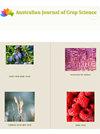Toxigenic fungi collected in maize fields from four states of Mexico
Q3 Agricultural and Biological Sciences
引用次数: 0
Abstract
Maize is the most important crop for the Mexican society. Phytopathogenic fungi pose a major challenge to this cereal. These fungi are harmful to people and animals, mainly as a result of their mycotoxins. The objective of this research was to identify the fungi found in 18 maize genotypes collected in fields from the states of Morelos, Coahuila, Chiapas, and Puebla, Mexico. Pathogens were isolated in potato dextrose agar (PDA) culture medium and identified using morphological criteria. The pathogens were purified using monoconidial cultures and sheltered at 4 °C ± 2 °C. An analysis of variance was carried out using the SAS® 9.1 statistical software. Fungi from the following genus and species were identified: Aspergillus, Penicillium, Alternaria, Bipolaris, Trichothecium roseum, and Fusarium verticillioides. It is worth mentioning that F. verticillioides and Penicillium sp. are the most common pathogens in maize genotypes, with an incidence of 63.68 and 6.57%, respectively. Moreover, along with genus Aspergillus, they are considered to be the most important toxicological fungi, given the harm that they cause to humans and animals. Therefore, management strategies are needed to guarantee that grains can be safely consumed by society从墨西哥四个州的玉米地里收集的产毒真菌
玉米是墨西哥社会最重要的作物。植物致病真菌对这种谷物构成了重大挑战。这些真菌对人和动物有害,主要是由于它们的真菌毒素。本研究的目的是鉴定在墨西哥莫雷洛斯州、科阿韦拉州、恰帕斯州和普埃布拉州采集的18种玉米基因型中发现的真菌。在马铃薯葡萄糖琼脂(PDA)培养基中分离病原菌,并用形态学标准进行鉴定。采用单孢子培养纯化病原菌,在4°C±2°C下保存。采用SAS®9.1统计软件进行方差分析。鉴定出以下属和种真菌:曲霉、青霉、互花菌、双极菌、玫瑰毛霉和黄萎病镰刀菌。值得一提的是,玉米基因型中最常见的病原菌为黄萎病单胞菌(F. verticillioides)和青霉菌(Penicillium sp.),发病率分别为63.68%和6.57%。此外,鉴于它们对人类和动物造成的危害,它们与曲霉属一起被认为是最重要的毒理学真菌。因此,需要制定管理策略来保证粮食能够被社会安全消费
本文章由计算机程序翻译,如有差异,请以英文原文为准。
求助全文
约1分钟内获得全文
求助全文
来源期刊

Australian Journal of Crop Science
农林科学-农艺学
CiteScore
1.20
自引率
0.00%
发文量
75
审稿时长
3.5 months
期刊介绍:
Information not localized
 求助内容:
求助内容: 应助结果提醒方式:
应助结果提醒方式:


